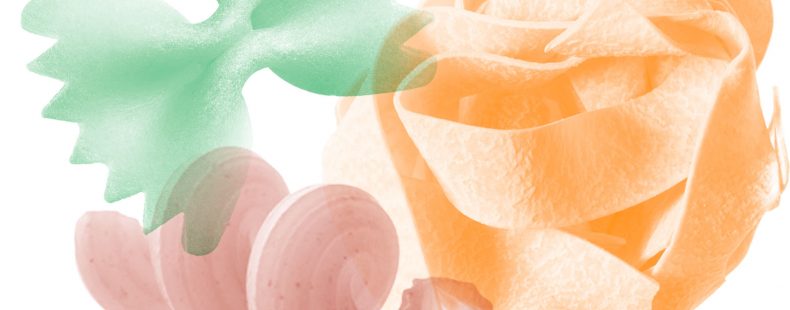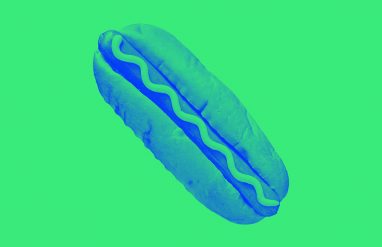The world of pasta is filled with endless pastabilities thanks to a vast variety of shapes and sizes. Each noodle shape has a name that might seem random if you’re not caught up on your Italian, but with a little help on the translation, it will all start to make more sense.
Think you know it all? We’ll go beyond spaghetti and penne and even serve up three new shapes: cascatelli, quattrotini, and vesuvio.
So grab your fork and take a bite out of what these pasta names really mean. You’ll learn which pastas are named after butterflies and which take after thin ropes, and the next time someone refers to farfalle as “the bow tie pasta” (the nerve!), you can get a little saucy!
cascatelli
Cascatelli was created by Dan Pashman, a James Beard Award winner and the host of The Sporkful podcast. The name—coined specially for the new shape—means “waterfalls” in Italian (properly cascatelle). The pasta, which took three years to develop in collaboration with the pasta company Sfoglini, has a half tube in the middle, features ruffles on both edges, and is somewhat like the shape of a caterpillar that’s half curled up. The goal for creating cascatelli was to produce a noodle that holds as much sauce as possible, is easy to pick up with a fork, and has a satisfying bite. After the viral success of cascatelli, Pashman teamed up with Sfoglini again to bring two other specialty shapes to the market: quattrotini and vesuvio.
quattrotini
Quattrotini is a new Sfoglini pasta developed by Pashman and based on a unique shape served only once a year in a small region in Sicily. It resembles four small tubes joined together as a square. In Italy, the shape is known as cinque buchi (“five holes”).
vesuvio
The new shape vesuvio, meant to resemble a volcano, takes its name from Mount Vesuvius and looks something like a twirling ribbon that is unraveling at one end. Its availability was very limited in the US, but Sfoglini plans to distribute it more widely now.
Now let’s take a look at the more traditional pasta shapes you’re likely to see at your table.
farfalle
The bow tie-wearing shape of the pasta world, farfalle is a rectangle with a pinched middle and zigzag edges. The word in Italian has nothing to do with fancy wear, however. Farfalle translates to “butterflies” in Italian, which is tied to the shape rather than any fancy colors. This type of pasta dates back to the 1500s in the northern Italian regions of Emilia-Romagna and Lombardia. Today, it’s often used in creamy dishes.
spaghetti
There’s a good chance you know spaghetti through and through if you’re even the slightest bit familiar with Italian pasta. You might even use spaghetti as shorthand for all Italian pasta shapes, but it actually refers to only one type: white, starchy pasta that’s in long strings and served with any variety of meat, tomato, or other sauces. Spaghetti comes from the Italian word spago, which means “thin rope.” Fun fact: spaghetti is the plural form. If you’re talking about one strand, the singular version is spaghetto.
fettuccine
Fettuccine is pasta cut into flat and narrow strips—and indeed, the word fettuccine comes from fetta, which means “slice” or “ribbon” in Italian. Dishes with fettuccine evolved and were popularized in the early 1900s. The most common dish that uses fettuccine in the US is fettuccine Alfredo made with flour, cream, and milk that’s topped with shrimp or chicken. It’s a more simple affair in Italy, typically served as just the noodles with butter and fresh Parmesan.
fusilli
The word fusilli was first recorded in English around 1925—30 and comes from fusillo (“little spindle”) in the southern Italian dialect. The shape is a corkscrew or spiral, and fusilli come in short noodles. It was originally made by rolling spaghetti noodles around thin rods to dry.
linguine
Like fettuccine, linguine is a long and flat noodle. Its name comes from the plural Italian word linguina, which means “tongue,” and linguine directly translates to “small tongues.” Whereas the other popular flat noodle fettuccine can stand up to heavier sauces, linguine is typically served with a thin white sauce and clams on top (linguine alle vongole).
macaroni
You can stick a feather in your cap and call it macaroni, but that does not, in fact, make it actual macaroni. The pasta is small and tubular and made from wheat flour. Macaroni is recorded in English around 1590–1600 and is likely from the Neapolitan dialect word maccarone, which itself comes from the Greek makaria, or “food made from barley.”
orecchiette
Orecchiette are small pieces of pasta that look somewhat like ears with a slightly cupped middle, which is appropriate since the name in Italian literally translates to “little ears.” The pasta shape comes from Puglia in southeastern Italy. Unlike many pasta shapes that machines can easily spit out, orecchiette is typically shaped by hand. It’s usually served with tomato sauce or a chunky sauce.
orzo
Most Italian pasta is either shaped into long noodles or shorter noodles with ridges that make it easy to pick up sauce. Not orzo. This pasta shape is defined by small, rice-like grains. In Italian, orzo means “barley.” Though it has its roots in Italy and an Italian name, orzo is common in Greek and other Mediterranean dishes, too.
pappardelle
Pappardelle is the name for another pasta shape that’s in the family of flat pasta noodles. It’s cut into much wider strips than fettuccine or linguine, but not as wide as lasagna. The name was first recorded in English around 1895–1900 and is the plural form of pappardella. It’s thought that the name is a derivative of the Italian verb pappare, which means “to gobble up or devour.”
penne
While Yankee Doodle was off calling feathers macaroni, he would have been better off if he was using penne. Penne is a tubular pasta with diagonally cut ends. The word penne is the plural of the Italian word penna, which means “pen,” “feather,” or “quill.”
ravioli
This type of pasta is designed to hold sauces and meats on the inside. Ravioli are small pastas that are stuffed with a filling and served with a sauce. They’re often square-shaped but can be circular, triangular, or any other shape you can imagine. The name comes from the Italian word raviolo, which means “little turnip.”
tortellini
Like ravioli, tortellini are a type of pasta filled with meat, cheese, or sauce. These are more specific on the shape, however: tortellini are folded into rings before they’re boiled and served in broth or with a sauce. The name tortellini is the diminutive form of tortello, which means something like “cake” or “fritter” and refers to a stuffed cake.
Finding the perfect pasta shape: the name of the game
If you’re looking to serve pasta and you’re in a situation where not just any plain old pasta will do, the good news is that you have plenty of options. Things can get a little confusing if you don’t enter the grocery store with a specific pasta shape in mind that’s perfect for what you’re looking to cook, though.
You have your standard go-tos that get the red sauce treatment—spaghetti is one of the most common that comes to mind here. Then there are the shapes that are specially designed to pick up and hold sauce, meat, and cheese, like the corkscrew-shaped fusilli or the specialty shape cascatelli. And don’t forget the flat noodles like fettuccine and the stuffed noodles like ravioli.
In short, there’s a wide world of Italian pastas out there. One of the best ways to know what you’re getting and why each noodle has the shape it does is to know what the name means. Spaghetti comes from the word for “rope,” for example, while fusilli comes from the word for “little spindle.”
Take the quiz
Perhaps you’re familiar with many of these types of pasta from ordering and eating them whenever you head out to your favorite Italian restaurant. If you want to give your brain something to chew on, our word list of pasta names is the secret sauce that can help you master these pasta terms. And once you’re done indulging in these pasta words, get ready for the final course: a quiz on pasta names!














